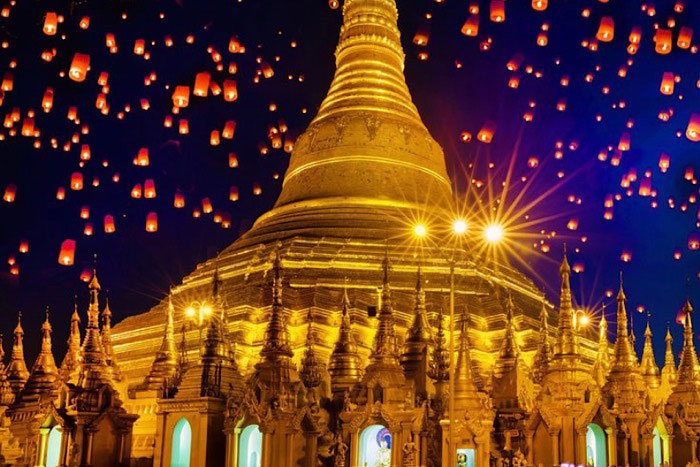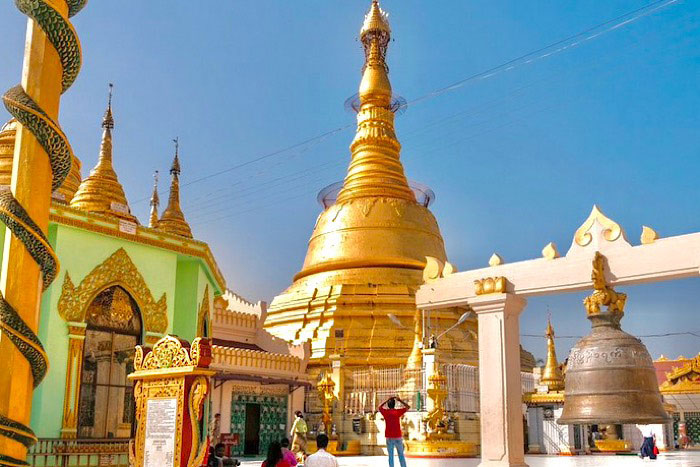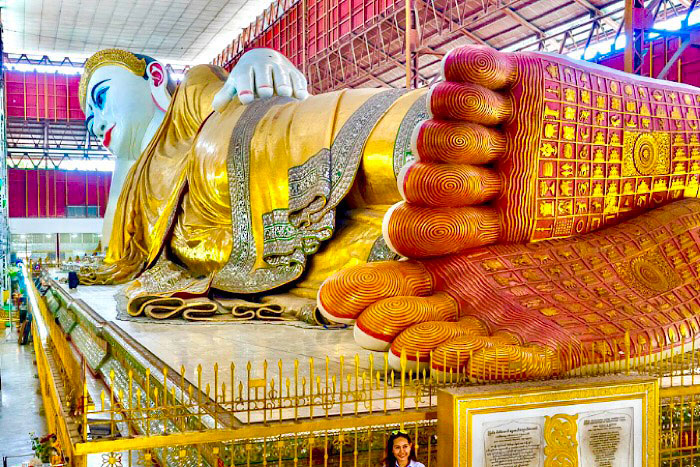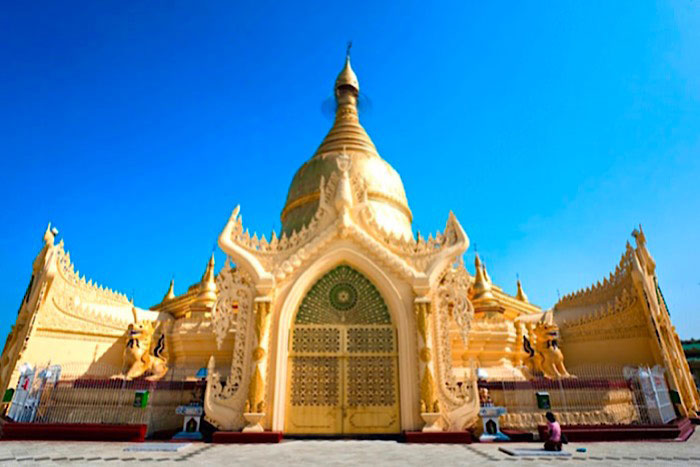Popular Pagodas In Yangon: Top 05 You Should Visit
Friday, November 03, 2023
Places to visit & things to do

Myanmar is known as the "Land of Buddhism," with numerous famous golden and sacred pagodas. The ancient capital of Yangon stands as Myanmar's largest tourist hub.Today, the city still preserves its history in its expansive, tree-lined boulevards and well-preserved colonial-era buildings. It stands adorned with numerous remarkable pagodas. So through this article of Autour Asia, you will discover the most amazing pagodas in Yangon.
Table of Contents
1. Shwedagon Pagoda - Top must-see pagodas in Yangon
- Address: Dagon, Yangon, Myanmar (Burma)
- Entrance ticket price: 8 USD/ pax
- Opening hours: 04:00 am - 10:00 pm
- Tel: +95 01 855 1012
- Google Maps: https://maps.app.goo.gl/YnPti9Yxnp7qgU879

If you are planning your trip to Myanmar, Shwedagon Pagoda is undoubtedly underlined on your list of the best places in Yangon. With a history of over 2500 years, this pagoda is intertwined with the lifetime of the Buddha. Historical records point to its construction by the Mon people around the 6th century. Over the centuries, it has undergone many expansions, renovations, and the addition of smaller stupas and accompanying structures. The most beautiful structure here is the imposing 99-meter-high pagoda, resplendent in gold plating and adorned with thousands of diamonds, rubies, and precious gemstones. This complex itself includes a wealth of other captivating structures, such as the Naungdawgyi pagoda, the Bell Pavilion houses, and the Arakanese Prayer Pavilion, .... Holding profound significance in Myanmar, this religious monument is one of the must-see pagodas in Yangon for the majority of the country's population, who adhere to Buddhism.
This pagoda can become quite bustling, particularly on weekends and during Buddhist festivals. Visitors are encouraged to dress modestly when visiting Shwedagon Pagoda, which means avoiding revealing clothing or shorts. Traditional Burmese longyis, a kind of long cloth worn by men, are available at the ticket booth for those in need. As a sign of respect, before entering the temple grounds, please remove your shoes and socks, either leaving them at the entrance or carrying them in a provided plastic bag. For an enchanting experience, we recommend visiting in the late afternoon and staying until sunset, when the play of light and colors on the pagoda creates a mystical ambiance. If you fancy a leisurely walk, the nearby People's Park offers a pleasant option.
2. Botataung Pagoda
- Address: Botahtaung Pagoda Road, Botahtaung Township, Yangon, Myanmar
- Entrance ticket price: 2 USD/pax
- Opening hours: 6:00 am - 10:00 pm
- Tel:+95-9971625813
- Google Maps: https://maps.app.goo.gl/PkFotQD77JDFyhS19

The Botataung Pagoda is one of the city's most historical places in Yangon. Its soaring 40-meter golden pagoda enshrines a sacred relic of the Buddha's hair. Nestled by the river in downtown Yangon, the Botataung Temple effortlessly melds the city's vibrant energy with its rich cultural heritage. This temple, built approximately 2,500 years ago by the Mon people, holds the distinction of being Myanmar's oldest Buddhist architectural marvel. Its name finds its roots in a historic event that unfolded over two millennia ago, when thousands of military leaders undertook the momentous journey from India to transport the Buddha's first hair relics, which were then enshrined in this pagoda.
Within the pagoda precinct, an array of smaller towers envelops the central core, where the primary stupa takes its rightful place. The heart of the pagoda is where the most sacred Buddha relics are safeguarded. Among them, the Bronze Royal Buddha image, cast in 1859 during King Mindon's reign, commands reverence. The Nat pavilion houses an almost life-sized effigy of Bo Bo Gyi, a revered Nat spirit believed to be the guardian of the pagoda. Nat worship remains an important aspect of contemporary Burmese spirituality. What sets the 40-meter-high golden pagoda apart is its unique feature—a hollowed-out stupa. While most stupas remain sealed and off-limits to the public, this one welcomes visitors to walk through its hallowed interior. Surrounding the central stupa, a series of pavilions add to the grandeur, with one pavilion showcasing an exceptional and resplendent bronze Buddha statue, meticulously cast in 1859. This pavilion is a testament to artistry and positive energy, inviting you to enter to immerse yourself in its beauty.
3. Chauk Htat Gyi Pagoda
- Address: Bahan Township, Yangon, Yangon Region, Myanmar
- Entrance ticket price: 5 USD/pax
- Opening hours: 6:00 am - 08:00 pm
- Google Maps: https://maps.app.goo.gl/mmPSiRJHkRZFruCD7

Located in the northeast of Shwedagon Pagoda, Chauk Htat Gyi Pagoda is well-known for its giant reclining Buddha statue, which is 65 meters long and 16 meters high. This is also a Buiddhist pagoda in Yangon. At the base of the giant Buddha statue are 108 sacred symbols of Buddhism. 59 of them are about humans, 21 are about the animal world, and 28 are about the world of gods, representing the noble meaning of transcending these levels and not being reborn in the Three Realms. You can also see a giant mural depicting Buddha from when he was a young prince to when he became a real Buddha, along with the activities of Him and the monks on the wall. In this temple, steel is used a lot to build structures. This has created a new style of Buddhist architecture that is larger and more convenient, creating space for a large, monumental Buddha statue.
The pagoda has wide, open spaces and high ceilings. So you can easily have a panoramic view and take pictures of the entire Buddha statue without any pillars blocking your view. This statue is 65 meters long, so you need to go around to explore and admire all the carved details. There are also steps beneath the Buddha statue, so visitors can see more clearly. Some styles inscribed in English and Burmese contain information about Buddhism and the Buddha's teachings. According to Eastern astrology, a week has 8 days because Wednesday is counted as two. Visitors will pay homage to Buddha by offering flowers and candles, then worship at the Buddha shrine on their birthday. A one-day festival is held in the temple every December. Instead of walking across the street to beg for alms, the monks were brought food by local people. In addition to the Buddha statue, the Shweminwon Sasana Yeiktha Meditation Center here attracts numerous local people to meditate here.
4. Maha Wizaya Pagoda
- Address: Shwedagon Pagoda Road in Dagon Township, Yangon, Myanmar
- Opening hours: 06:00 am - 10:00 pm
- Google Maps: https://maps.app.goo.gl/1DzhYNrmcbdFXzB38

This grand structure is one of the historical places in Yangon. It is located on top of a hill opposite the iconic Shwedagon Pagoda. The decoration combines modern and traditional styles. The customary decorations here are all done by artisans to protect the national culture created from ancient times to the present. Maha Wizaya Pagoda has important historical significance because it houses relics contributed and built by the King of Nepal. It was built at the first unification conference of Theravada Buddhism in Burma and was funded by donations from Buddhists across Burma. Inside the main stupa is a circular room with a dome above. In the middle of the room is a shrine to Buddhist relics, and surrounding the base of the temple are a number of Buddha statues.
Hti tower has an umbrella shape on top of the pagoda and has 11 floors. The center of the temple is the main stupa. Unlike the stupa in Myanmar, this stupa is hollow and open for visitors to freely visit and admire. The domed ceiling is painted light blue and decorated with many drawings of animals. When you come to Maha Wizaya Pagoda, this is a world where spirituality is accompanied by architectural brilliance. The golden color of the pagoda under the bright sunlight creates a great scene against the clear blue sky. Maha Wizaya Temple is not only an iconic structure but also a symbol of devotion and spiritual enlightenment. If you are looking for artistic inspiration or simply want to immerse yourself in Myanmar's vibrant culture, this painting will show you another world filled with beauty and peace.
5. Kaba Aye Paya Pagoda
- Address: Kabar Aye Pagoda Rd, Yangon, Myanmar (Burma)
- Entrance ticket price: 5 USD/pax
- Opening hours: 6:00 am - 08:00 pm
- Google Maps: https://maps.app.goo.gl/nXMdQwTcFRKWVCLU9

Kaba Aye Paya or World Peace Pagoda was built in 1952 by U Nu, the Prime Minister of Burma, to host the 6th Buddhist Congress right after Buddha entered Nirvana about 2,500 years ago. This is a Buiddhist pagoda in Yangon. The hall's six entrances and the six large pillars supporting the roof represent the six councils. Furthermore, surrounding the columns are golden statues of Buddhas such as Kassapa Buddha, Kakusandha Buddha, Konagamana Buddha and Gautama Buddha. Inside the hollow pillar is a large silver Buddha statue sitting on an elaborate pedestal. On the walls, there are many smaller images in different positions. Around the lower part of the pagoda is a very colorful circular structure that has five entrances. Large niches in the middle of the entrances house Buddha statues standing in front of murals.
In addition, the pagoda also has a stupa with a height of 36 meters and a circumference around the base of the tower of 34 meters. Visitors will be attracted by the temple's golden dome and beautifully carved arches. The golden dome is decorated with multi-tiered hti and shaped like an umbrella. The lower part of Kaba Aye is a colorful structure consisting of five entrances decorated in the traditional style of carved lotus flowers. The Kaba Aye complex includes many monasteries, staircases, and vendors selling handicraft products. Also on site is a Buddhist art museum and Buddhist learning center, as well as a fishpond where large catfish are fed by devotees to create merit. Vendors at the entrance sell candles, incense and other items to devotees who come to make merit. Vendors at the entrance sell candles, incense and other items to devotees who come to make merit.
These 05 renowned pagodas in Yangon, Myanmar, rank among the most exquisite in the entire nation. If you find yourself blessed with ample time to explore Yangon, we wholeheartedly recommend visiting all 05 of these magnificent sites.
Worried about the plan to travel in Yangon? Don't be! Share your travel aspirations with us, and our dedicated travel advisors will be delighted to offer suggestions and expert guidance for your trip arrangements. We specialize in crafting tailor-made experiences that align with your unique interests and preferences, all in the pursuit of curating the perfect Myanmar vacation for you.
You can refer to our program to explore more places in both Yangon in particular and Myanmar in general. Please CONTACT our travel consultant for more details.
It is advisable to refer to the following circuits:
>> Myanmar Packages Tours
>>Myanmar Travel itinerary 2 weeks
>>Myanmar 9 days
>> Myanmar Packages Tours
>>Myanmar Travel itinerary 2 weeks
>>Myanmar 9 days
Related travel guide
Other similar articles
CUSTOMIZABLE BY LOCAL EXPERTS
Personalized trip at the original price!
REFUND GUARANTEE
We believe in our work and promise to give you money back.
GOOD PRICE / QUALITY
95% satisfied more than expected!
24/7 LOCAL SUPPORT
We are always available online to provide assistance at any time.
Most read articles
Autour Asia is highly recommended on
Embracing the mission of "Satisfied more than expected" and providing authentic experiences, we have received numerous recommendations on reputable travel forums:























